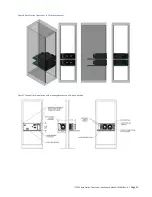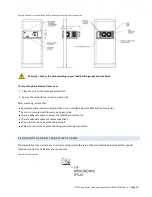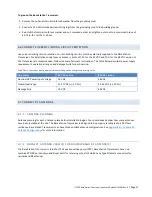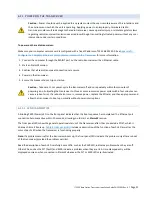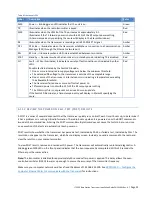
ITC 220 Base Station Transceiver Installation Guide PN 133991 Rev. A
| Page 7
2
FOLLOW ESTABLISHED SAFETY GUIDELINES
Your employer has created safety guidelines that apply to your work environment and tasks. Please follow them. If you
have questions about general on-the-job safety concerns, please consult your employer’s established safety guidelines.
2.1
ELECTRICAL SAFETY
To reduce the risk of electric shock:
Follow your employer’s established electrical safety guidelines.
Disconnect power from the transceiver before removing the cover.
Be aware that removing the cover of the radio transceiver may expose you to dangerous voltages or other risks.
Avoid making internal adjustments to the radio transceiver when you are alone.
Avoid contact with a radio’s electrical components. Electric shock from voltages present with the radio transceiver
are potentially fatal.
Reassemble radio transceivers correctly. Incorrect reassembly of a radio transceiver can cause a harmful electric
shock to anyone who handles it.
3
IMPORTANT INFORMATION FOR THE USER
3.1
TRANSMITTER WARMUP PERIOD
The transmitter uses a precision oven-controlled crystal oscillator (OCXO). The OXCO warm-up period is one minute
minimum after application of input power before any transmission should commence.
3.2
LIMITING RF EXPOSURE
Caution
– Please refer to the
RF Energy Exposure Guide for ITC 220 Base Station, Locomotive, and Wayside
Transceivers Installed in Vehicles or at Fixed Sites
that is packaged with each Base Station and Locomotive
Transceiver and available online or by request for specific information regarding safe distances that must be
maintained between personnel and energized transmitting antennas.
The information in the
RF Energy Exposure Guide for ITC 220 Base Station, Locomotive, and Wayside Transceivers
Installed in Vehicles or at Fixed Sites
(
RF Energy Exposure Guide
) is determined form FCC and Industry Canada rules
that, when followed, limit human exposure to radio frequency energy to acceptable levels. Note that although the Base
station is expected to be sited, installed, and maintained only by professionals in a controlled-exposure environment,
the
RF Energy Exposure Guide
lists the larger lateral safe distances for an uncontrolled environment. Obeying these
limits will protect both railroad employees and the general public.
The Base Station Transceiver is intended to be operated with a fixed antenna in an Occupational/Controlled Exposure
environment per FCC OET 65 or Controlled Use Environment per IC RSS-102. The Maximum Permitted Exposure (MPE)
limit for devices in the presence of the general public in the 100-300 MHz range is 0.2 mW/cm
2
= 2 W/m
2
vs. 10 W/m
2
in a controlled-exposure environment.
This radio transceiver is intended for use by railroad employees who have full knowledge of their exposure and can
exercise control over their exposure to meet FCC and IC limits. This radio device is not intended for use by consumers
or the general population. Base station antennas must be positioned on towers or nonresidential buildings that are
generally unoccupied except while servicing the equipment therein.





















